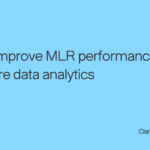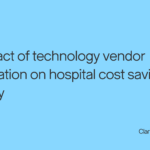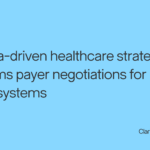Providing high-quality care while keeping costs under control can often feel mutually exclusive. Health plans want to deliver the best possible care for their members, and that frequently takes a financial investment. But from a business perspective, health plans must find that balance between providing high-quality care at a lower cost for their members, and those that do will reap the benefits of better growth, improved member retention, and enhanced health plan profitability. Predictive analytics is one of the best tools to help health plans manage costs. From helping to manage chronic conditions more effectively to improving care coordination to setting the foundation for personalized wellness programs, predictive analytics in healthcare can serve as a secret weapon to boost the quality of the services health plans offer while keeping costs under control. The healthcare industry is in the midst of a transition. With an aging population of baby boomers living longer and needing more care while the industry is facing an unprecedented workforce shortage; healthcare organizations are seeking solutions that allow them to be more efficient and responsive to the challenges inherent in today’s healthcare environment. A significant driver of these challenges is the increase in chronic conditions in U.S. adults. The population of those 65 years and older accounts for more than one-third of healthcare costs – a number expected to increase significantly over the next 25 years. By 2060, the Centers for Disease Control and Prevention estimates that older adults will make up 25% of the U.S. population. That is why health plans need to get ahead of those costs now. Sixty percent of all adults have a chronic disease, and nearly half are managing two or more chronic conditions. Heart disease, cancer, diabetes, and other chronic conditions drive up a substantial portion of healthcare costs for health plans due to their long-term nature and the frequent need for medical intervention. As people live longer with chronic conditions, implementing cost-effective solutions for patients and health plans is becoming increasingly important. Predictive analytics is an incredibly powerful tool to help health plans keep long-term care costs lower. Leveraging health data and individual patient risk factors, plans can identify those members with, or at a higher risk of, developing chronic conditions. Knowing who these members are means health plans can proactively manage their care and develop personalized care plans tailored to each individual’s needs. Getting ahead of and managing chronic conditions can lead to better health outcomes, lower costs, and increase member satisfaction by preventing complications and reducing the need for expensive treatments. This supports the health plan’s growth by improving its financial performance and enhancing its reputation for delivering high-quality, personalized care. Care transitions are a point of vulnerability in the healthcare system. Poor communication, ineffective patient and caregiver education, lack of timely follow-up care, failure to address multiple chronic conditions, and inadequate access to care have all been identified as root causes of failed or poor care coordination. This fragmented care can lead to inefficiencies, higher costs, and suboptimal outcomes. When a member’s care is especially complex, care transitions are critical to ensuring and maintaining a high level of care quality. However, health plans often struggle with ensuring that different providers involved in a member’s care work together effectively. Poor care coordination stems from an inability to see the full picture of a patient’s care journey. Being overly focused on one part of a patient’s care or failing to account for a specialist providing care for a chronic condition can leave critical gaps in knowledge and understanding of a care plan. Predictive analytics can help identify such gaps in care coordination. Analyzing patient data and care pathways to highlight areas lacking coordination allows health plans to foster more effective and streamlined collaboration and communication among providers. Improved care coordination ensures a seamless care experience for members, reduces unnecessary expenses, and enhances the overall quality of care. This can lead to better health outcomes and increased member satisfaction, which are crucial for the plan’s growth. Ultimately, this helps boost a health plan’s competitive edge. Companies are increasingly investing in wellness programs to meet the holistic healthcare needs of their employees, making such programs a viable option for many health plans. Mental health services, gym memberships, weight loss programs, self-care benefits, and other similar offerings are designed as preventive health measures to help improve employees’ health while avoiding illness. In the post-COVID-19 era, many organizations have focused more on providing a mix of physical, emotional, mental, spiritual, financial, and social support. However, one size does not fit all when it comes to wellness programs, and health plans only do themselves and their members a disservice when applying a blanket approach to such offerings. Generic wellness programs may not address the specific needs of all members, leading to underutilization and limited impact on health outcomes. And with few people using the services or when there is a failure to see any real health benefit, the solution is often to cut wellness programs, which can also hurt member satisfaction. Predictive analytics can provide valuable insights into health and wellness programs and services members want and use. Plans can segment the member population based on health risks and preferences, allowing for the development of personalized wellness programs. Customized programs based on members’ preferences can lead to higher engagement, better health outcomes, and reduced healthcare costs, enhancing the value proposition of the health plan to current and prospective members. Predictive analytics in healthcare help health plans create a full picture of who their members are and what they want from their health plan. Leveraging this data to manage chronic health conditions, improve care coordination, and develop wellness plans enables health plans to better meet their members’ needs and offers a cost-effective roadmap for services. Knowing what members want and need allows payers to offer those services while avoiding services or care that will be underutilized.Managing chronic conditions with predictive analytics
Improving care coordination with predictive analytics data
Using predictive analytics data to develop personalized wellness programs
Predictive analytics provides a full view of patients
- Author Details





